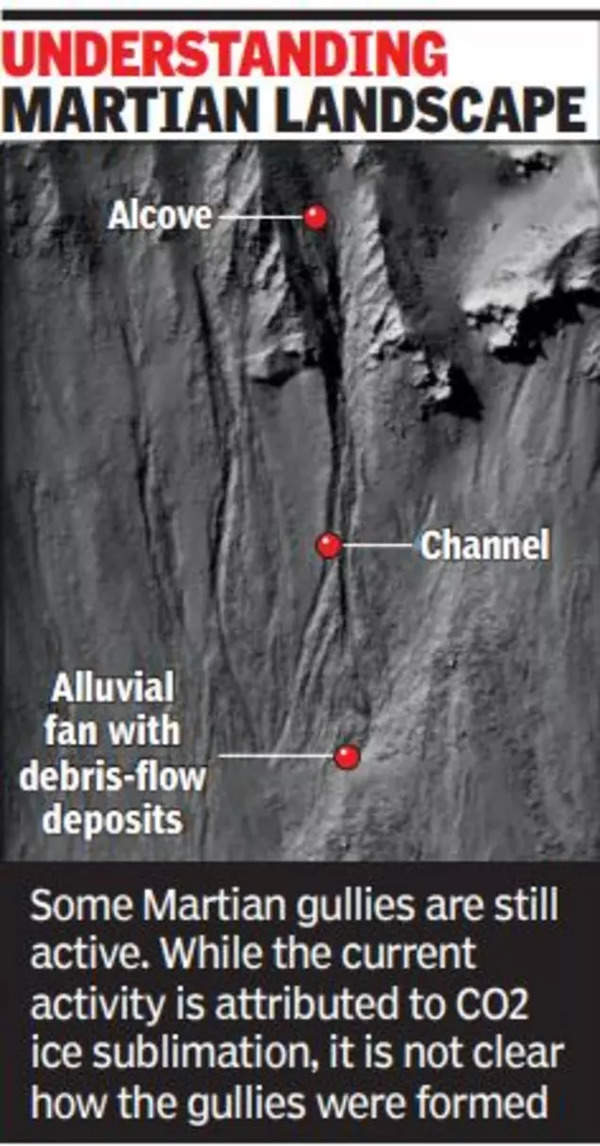AHMEDABAD: A doctoral study at IIT Gandhinagar (IIT-Gn) by a scientist of the Physical Research Laboratory (PRL) has found 20 new sites on Mars where gullies - similar to water-carved channels on Earth -- have been found with debris-flow deposits.
While the study aims at explaining these formations, the findings also point to the possible role of water in its liquid form in the formation of the landform in the past.

Gullies are geological features where the water or mass movement leaves behind a gap through erosion of soil. With the discovery of gullies on Mars, especially after the scientific missions to the red planet in the past 20 years, scientists have been trying to understand their formation in places where no flowing water has been detected.
Doctoral research by Rishitosh Kumar Sinha, a scientist with the Planetary Sciences Division of the PRL, at IIT-Gn indicated that while 'active' gullies today change shape due to movement of carbon dioxide ice during seasonal change, it would have been water that caused these gullies to form in the past few million years.
The research titled 'Glacial landforms and gully formation on Mars' was carried out under the guideship of Dr Dwijesh Ray, associate professor at Planetary Sciences Division of PRL.
'Future missions can try to understand the formation of gullies on Mars'
The research started from the point that there has been a search for water on the Martian surface. If there was water there in the past, where did it go? Did it evaporate or go subsurface? The Mars Global Surveyor in 2000 showed the gully formations on Mars for the first time, and thus began the quest to understand whether it was formed by water gushing down," said Sinha.
After water came the other candidate - carbon dioxide ice. The sublimation process - where the solid state directly converts into gaseous form bypassing liquid form - with ice causing the gas released from the surface to cause debris flow deposits may have furthered the gully formation.
"In this context, the study looked at the possible roles of water and carbon dioxide in the formation of these gullies. The intriguing part was that many of these gullies showed signs of extension or change. If we rule out water, the only explanation that remains is carbon dioxide. But only carbon dioxide cannot explain the formation of the entire cluster of gullies. Thus, one must take into consideration the earlier impact of water in the formation of these gullies," said Sinha. "However, the current changes can be attributed to carbon dioxide. Perhaps future missions can find water residues in the form of ice in the Martian gullies, providing us the ultimate proof of water's presence and role."
His study contributed to the discovery of 20 different gully formations on Mars which was not reported earlier. "For the first time, global morphological analysis of gullies using high resolution images from the Mars Reconnaissance Orbiter (MRO) was conducted and 20 new sites with evidence of debris-flow deposits in Martian gullies were reported," said Sinha, adding that previously only six sites were known to have preserved the morphological signatures of debris-flow deposits.
These 20 sites are widespread in the middle latitudes of Mars and point to formation of debris flow similar to what is found on Earth. Debris flow is a rapid movement of a concentrated mixture of sediment and organic matter caused by gravity, quite similar to a massive landslide. "But while such debris flows are known to be caused by water, on Mars, we need to infer the role of water in its liquid form for the same. The gullies formed by debris-flow like processes do not show any relationship with the present-day carbon dioxide ice sublimation process. We must take into consideration the potential flow of water on Mars during the past few million years," he added.
The research does not imply that water was the only force, said Sinha, and there could be other factors too, but the role of flowing water cannot be ignored. He added that carbon dioxide ice deposits alone cannot explain all gullies. "The outcome would be helpful in finding a potential site for a mission to Mars by India or other countries. The current rovers have a visibility of a few metres. For further understanding of the formation of gullies, the rovers must have a range of 1-2 metres so that they can look at the near-subsurface of gullies," said Sinha, adding that it would hold the key to understanding water on Mars.
"flow" - Google News
September 11, 2023 at 08:31AM
https://ift.tt/fgCmXta
Gujarat scientist discovers 20 gully sites on Mars with debris-flow deposits - Times of India
"flow" - Google News
https://ift.tt/qLwYXtx
https://ift.tt/z5Inw8W
Bagikan Berita Ini














0 Response to "Gujarat scientist discovers 20 gully sites on Mars with debris-flow deposits - Times of India"
Post a Comment